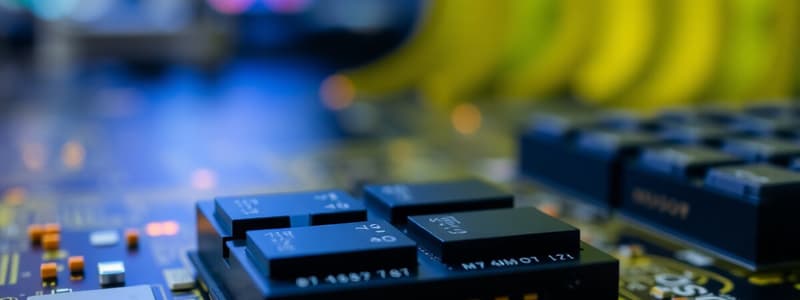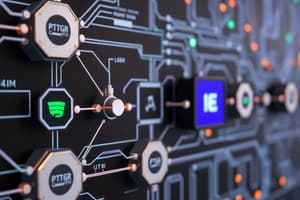Podcast
Questions and Answers
Which layer of the Internet Protocol Suite is responsible for routing data packets across networks?
Which layer of the Internet Protocol Suite is responsible for routing data packets across networks?
- Application Layer
- Link Layer
- Internet Layer (correct)
- Transport Layer
What is the primary function of the Dynamic Host Configuration Protocol (DHCP)?
What is the primary function of the Dynamic Host Configuration Protocol (DHCP)?
- Assigning IP addresses to devices on a network (correct)
- Providing a unique device identifier for each network interface
- Encrypting communication between a client and a server
- Translating domain names to IP addresses
Which component of the operating system is used to manage memory?
Which component of the operating system is used to manage memory?
- Kernel Modules
- Storage Devices
- Virtual Memory (correct)
- System Services
What is a primary purpose of Network Address Translation (NAT)?
What is a primary purpose of Network Address Translation (NAT)?
Which type of software is explored in project #25?
Which type of software is explored in project #25?
Which of the following is NOT a focus of the provided projects related to operating systems?
Which of the following is NOT a focus of the provided projects related to operating systems?
Which of the following best describes the primary function of an Operating System (OS) kernel?
Which of the following best describes the primary function of an Operating System (OS) kernel?
What distinguishes 'kernel mode' from 'user mode' in an operating system?
What distinguishes 'kernel mode' from 'user mode' in an operating system?
What is the role of an Application Programming Interface (API) in the context of operating systems?
What is the role of an Application Programming Interface (API) in the context of operating systems?
Which of the following best describes the purpose of Virtual Memory?
Which of the following best describes the purpose of Virtual Memory?
What is the primary role of a device driver in an operating system?
What is the primary role of a device driver in an operating system?
What does the term 'daemon' typically refer to in an operating system context?
What does the term 'daemon' typically refer to in an operating system context?
Regarding object-oriented programming, which basic concept is NOT mentioned in the provided excerpt?
Regarding object-oriented programming, which basic concept is NOT mentioned in the provided excerpt?
What is the key difference between compiled and interpreted programming languages as discussed in the text?
What is the key difference between compiled and interpreted programming languages as discussed in the text?
What is primarily covered in Chapter 10 regarding operating systems?
What is primarily covered in Chapter 10 regarding operating systems?
Which of the following programming languages is mentioned in Chapter 9?
Which of the following programming languages is mentioned in Chapter 9?
What major topic is addressed in Chapter 11 regarding the internet?
What major topic is addressed in Chapter 11 regarding the internet?
In Chapter 12, which of the following technologies related to the web is NOT mentioned?
In Chapter 12, which of the following technologies related to the web is NOT mentioned?
What is the main focus of Chapter 13 regarding modern computing topics?
What is the main focus of Chapter 13 regarding modern computing topics?
Which aspect of computer architecture is primarily discussed in Chapter 7?
Which aspect of computer architecture is primarily discussed in Chapter 7?
Which chapter introduces the concept of low-level machine code?
Which chapter introduces the concept of low-level machine code?
Which topic discussed in Chapter 9 best describes characteristics of high-level programming languages?
Which topic discussed in Chapter 9 best describes characteristics of high-level programming languages?
Flashcards
Digital Data
Digital Data
The representation of information using discrete values, like 0s and 1s in binary.
Analog Data
Analog Data
The representation of information using continuous values, like a dial on a radio.
Binary Number System
Binary Number System
A numbering system using only the digits 0 and 1.
Logical Operators
Logical Operators
Signup and view all the flashcards
Voltage
Voltage
Signup and view all the flashcards
Current
Current
Signup and view all the flashcards
Resistance
Resistance
Signup and view all the flashcards
Transistors
Transistors
Signup and view all the flashcards
The Internet
The Internet
Signup and view all the flashcards
The Internet Protocol Suite
The Internet Protocol Suite
Signup and view all the flashcards
Link Layer
Link Layer
Signup and view all the flashcards
Internet Layer
Internet Layer
Signup and view all the flashcards
Transport Layer
Transport Layer
Signup and view all the flashcards
Application Layer
Application Layer
Signup and view all the flashcards
Dynamic Host Configuration Protocol (DHCP)
Dynamic Host Configuration Protocol (DHCP)
Signup and view all the flashcards
Domain Name System (DNS)
Domain Name System (DNS)
Signup and view all the flashcards
Object-Oriented Programming
Object-Oriented Programming
Signup and view all the flashcards
Compiler
Compiler
Signup and view all the flashcards
Interpreter
Interpreter
Signup and view all the flashcards
Daemon
Daemon
Signup and view all the flashcards
Application Programming Interface (API)
Application Programming Interface (API)
Signup and view all the flashcards
User Mode
User Mode
Signup and view all the flashcards
Kernel Mode
Kernel Mode
Signup and view all the flashcards
Virtual Memory
Virtual Memory
Signup and view all the flashcards
Study Notes
Book Title and Author
- How Computers Really Work
- Matthew Justice
Introduction
- Computers are ubiquitous in daily life (homes, schools, offices, pockets, etc.)
- Understanding computers is important for today's society.
- A hands-on approach with exercises and projects is utilized throughout the book
- The goal is to give an entry point for understanding computer concepts.
Studying That Suits You
Use AI to generate personalized quizzes and flashcards to suit your learning preferences.



